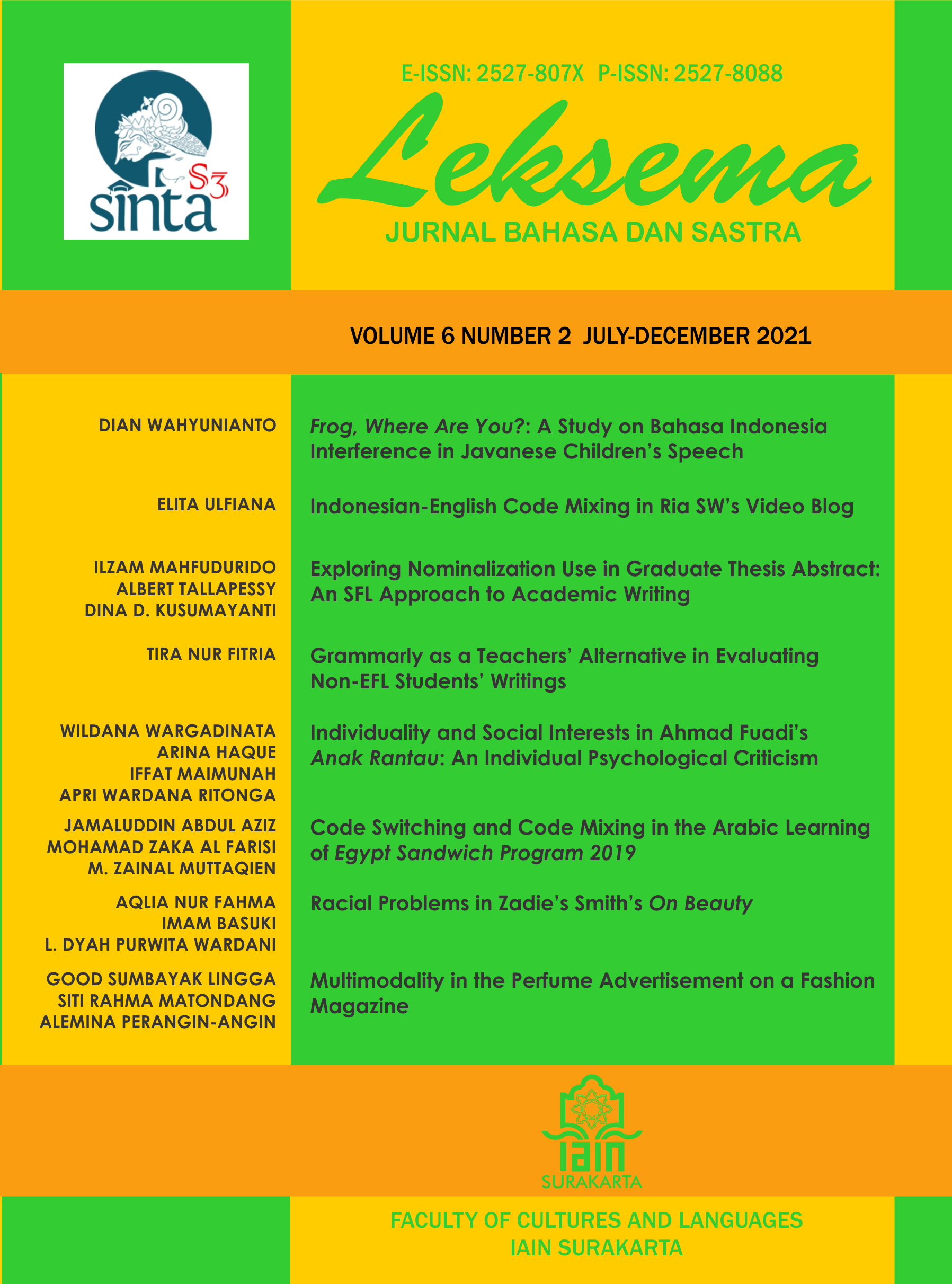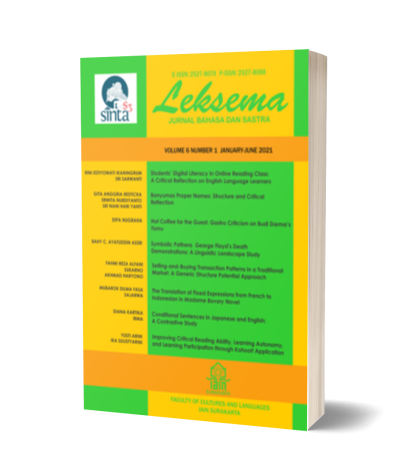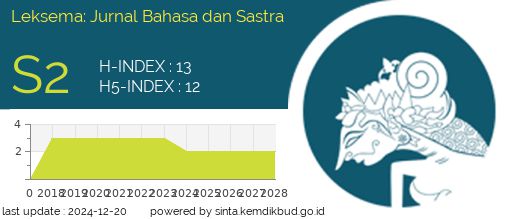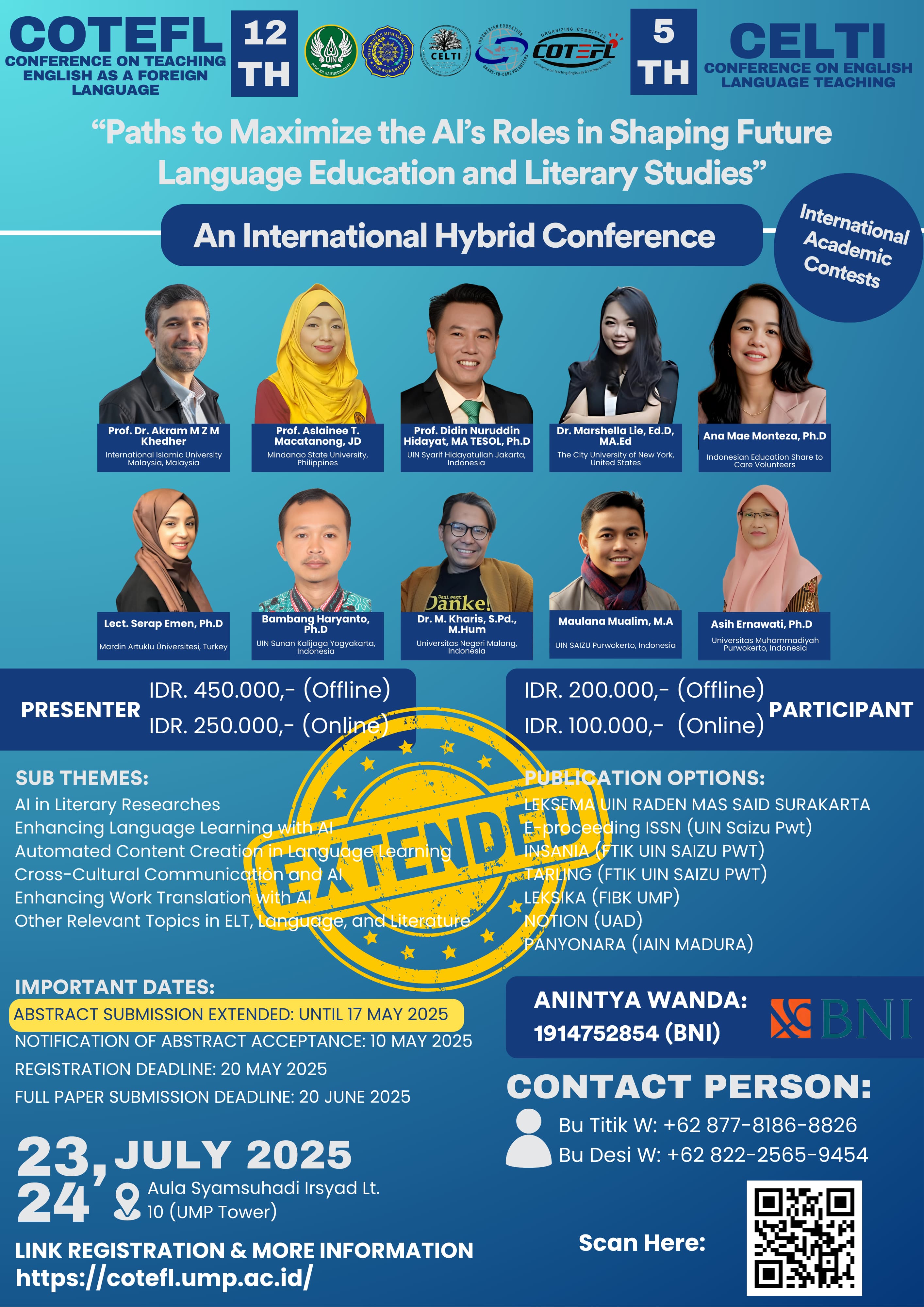EXPLORING NOMINALIZATION USE IN GRADUATE THESIS ABSTRACTS: AN SFL APPROACH TO ACADEMIC WRITING
DOI:
https://doi.org/10.22515/ljbs.v6i2.3888Keywords:
academic writing, grammatical metaphor, nominalization, thesis abstractAbstract
Abstract becomes the mandatory part of an article which should be concise and lexically condensed. Unfortunately, not all academic writers can meet this demand. Following Halliday & Matthiessen’s (1999) types of the grammatical metaphor in which the nominalization plays as the main tendency of the construal, this study investigates nominalization cases and how they are manifested in the texts. Seven graduate students’ thesis abstracts of the Linguistics Department of a state university in Indonesia were opted as the object of the investigation. Each instance of the nominalization was coded, counted, and classified to decide their types and an in-depth elaboration of how they are manifested in the texts is provided as well. The results showed that the graduate students employed all types of the nominalization to increase the abstracts’ conciseness. The Process nominalization realized from the process-thing transference highly dominates the abstracts. The findings also reveal a wide gap of the nominalization use between the process nominalization and the other types indicating the students’ lower intermediacy of the nominalization mastery in the academic writing. Therefore, the explicit teaching of the nominalization is highly recommended as this could be of value to the students involved in the scientific publication in this university.
Downloads
References
Afifi, Nur. 2021. “Exploring the Use of Grammatical Metaphor in Indonesian EFL Learners’ Academic Writing.†Indonesian Journal of Applied Linguistics10 (3): 719-731. https://doi.org/10.17509/ijal.v10i3.31759
Al-Khasawneh, Fadi Maher. 2017. “A Genre Analysis of Research Article Abstracts Written by Native and Non-Native Speakers of Englishâ€.Journal of Applied Linguistics and Language Research 4(1): 1-13
Bhatia, Vijay Kumar. 1993. Analysing Genre: Language Use in Professional Settings. London: Longman
Biber, Douglas, Susan Conrad, & Geoffrey Leech. 2002. A Student Grammar of Spoken and Written English. London: Longman
Biber, Douglass & Bethany Gray. 2010. “Challenging Stereotypes about Academic Writing: Complexity, Elaboration, Explicitness.†Journal of English for Academic Purposes 9 (1): 2-20. https://doi.org/10.1016/j.jeap.2010.01.001
Derewianka, Beverly. 1995. Language Development in The Transition from Childhood to Adolescence: The Role of Grammatical Metaphor (PhD Dissertation). Sydney, Australia: School of English and Linguistics-Macquarie University. http://hdl.handle. net/1959.14/176445
Eggins, Suzanne. 2004. An Introduction to Systemic Functional Linguistics (2nd Edition). New York: Continuum
Ezeifeka, Chinwe R. 2015. “Grammatical Metaphor: In Search of Proficiency in Research Abstract Writingâ€. SAGE Open 5 (1): 1-14. https://doi.org/10.1177%2F21 582440 15577 667
Fang, Zhihui. 2005. “Scientific Literacy: A Systemic Functional Linguistics Perspectiveâ€. Science Education 89 (2): 335-347. http://dx.doi.org/10.1002/sce. 20050
Fatonah. 2014. “Students' Understanding of the Realization of Nominalizations in Scientific Text.†Indonesian Journal of Applied Linguistics 4(1): 87-98. http://dx.doi.org/ 10.17509/ ijal.v4i1.602
Halliday, Michael Alexander Kirkwood & James Robert Martin. 1993. Writing Science: Literacy and Discursive Power. London: Falmer Press
Halliday, Michael Alexander Kirkwood. 1998. “Things and Relations: Regrammaticizing Experience as Technical Knowledgeâ€. In J. Martin & R. Veel (Eds.). Reading Science: Critical and Functional Perspectives on Discourses of Science. (185-235). London: Routledge
Halliday, Michael Alexander Kirkwood & Christian Matthias Ingemar Martin Matthiessen. 1999. Construing Experience Through Meaning. A Language Based Approach to Cognition. London: Continuum
Holtz, Mônica. 2009. Lexico-grammatical Properties of Abstracts and Research Articles: A Corpus-Based Study of Scientific Discourse from Multiple Disciplines (PhD Dissertation). Darmstadt: Department of Linguistics and Literary Studies, Technische Universitat
Darmstadt
Lorés, Rosa. 2004. “On RA Abstracts: From Rhetorical Structure to Thematic Organizationâ€. English for Specific Purposes 23 (3): 280-302. DOI:10.1016/j.esp.2003.06.001
Mahmudah, Hajrah, Arni Amir & Muhamad Ahkam Arifin. 2018. “Grammatical Metaphor in Academic Texts of Indonesian Students’ Thesis.â€International Journal of Humanities and Innovation (IJHI)1(1): 54-61. DOI: 10.33750/ijhi.v1i1.8
Morley, George David. 2000. Syntax in Functional Grammar. An Introduction to Lexicogrammar in Systemic Linguistics. New York: Continuum
Nys, Mathias. 2018. Grammatical Metaphor in Non-Native English Academic Writing A Comparison of Higher-Marked and Lower-Marked Papers Written by Non-Native University Students (Master Thesis). Ghent: Faculty of Arts and Philosophy, Ghent University
Ravelli, Louise Jane. 1999. Metaphor, Mode and Complexity: An exploration of Co-varying Patterns. Nottingham: Department of English and Media Studies, Nottingham Trent University
Refnaldi. 2015. “When Verbs Become Nouns: Grammatical Metaphor in Students' Academic Textsâ€. Proceedings of the Third International Seminar on English Language and Teaching. 3: 27-33. Padang: Universitas Negeri Padang
Schleppegrell, Mary Jane.2004. “Technical Writing in a Second Language: The Role of Grammatical Metaphorâ€. In LJ Ravelli & RA Ellis (Eds.). Analysing Academic Writing: Contextualized Frameworks (172-189). New York: Continuum
Snow, Catherine & Paula Uccelli. 2009. The Challenge of Academic Language. In D. Olson & N. Torrance (Eds.). The Cambridge Handbook of Literacy (112-133). Cambridge: Cambridge University Press. http://dx.doi.org/10.1017/cbo9780511 609664.008
Wenyan, Gao. 2012. “Nominalization in Medical Papers: A Comparative Studyâ€. Studies in Literature and Language 4(1): 86-93
Downloads
Published
Issue
Section
License
The copyright of the received article shall be assigned to the publisher of the journal. The intended copyright includes the right to publish the article in various forms (including reprints). The journal maintains the publishing rights to published articles.
In line with the license, the authors and users (readers or other researchers) are allowed to share and adapt the material only for non-commercial purposes. In addition, the material must be given appropriate credit, provided with a link to the license, and indicated if changes were made. If authors remix, transform or build upon the material, authors must distribute their contributions under the same license as the original.







